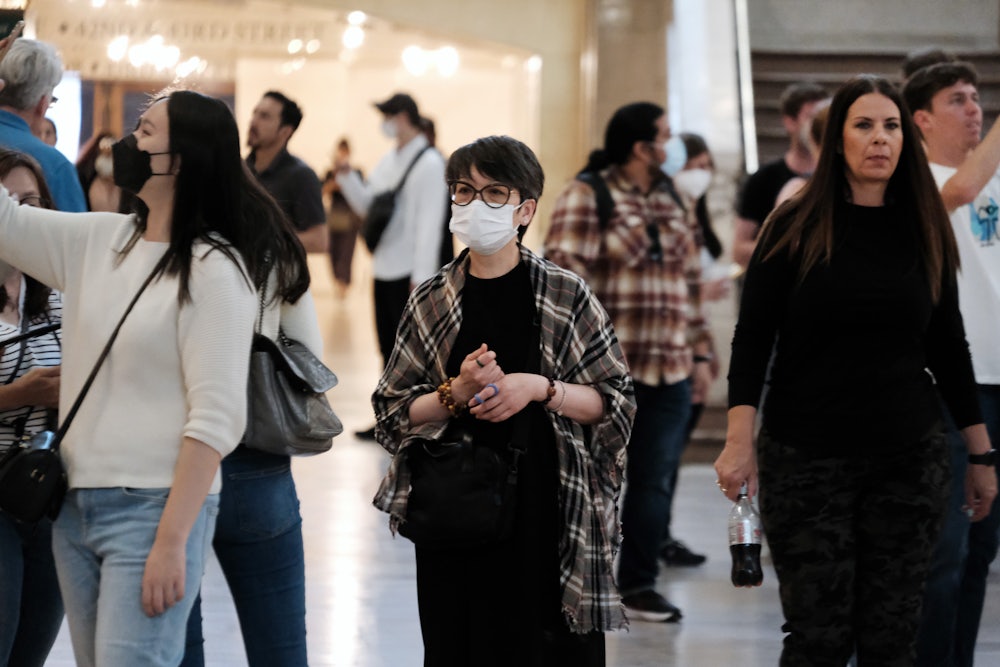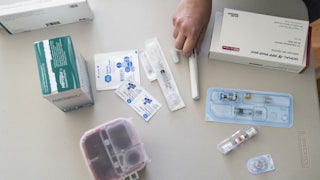Four years after the Covid-19 pandemic slammed into the United States, forcing shutdowns and killing 1.1 million people and counting, the U.S. is considering one of the final steps that might cement Covid’s status as just another virus, similar to the flu or RSV: Instead of recommending a period of isolation for those who test positive for Covid, the U.S. Centers for Disease Control and Prevention plans to recommend a symptom-based system, anonymous agency officials recently told The Washington Post. If someone has been fever-free for 24 hours and other symptoms are improving, they would be free to leave isolation; presumably those without symptoms or without fever would never isolate, even while they are testing positive. This could be part of broader new “pan-respiratory guidance,” a topic CDC director Mandy Cohen reportedly broached last fall.
While public appetite for Covid news is low, experts say the stakes for communicating about respiratory illnesses are deceptively high. An ongoing bird flu outbreak and a small but deadly swine flu outbreak in Colombia this year have public health experts worried that another flu pandemic is all but assured in coming years. As government officials downplayed Covid, flu, and other deadly viruses in recent years—shortening Covid isolation times and lifting restrictions—misinformation about measles, another respiratory illness, has proliferated. A massive measles outbreak is currently roiling Europe, and Florida has now reported multiple cases at a single school. State officials who rose to prominence by opposing Covid measures said the 200 unvaccinated students who had been exposed did not need to quarantine.
Then there is the threat of more novel viruses; dangerous new coronaviruses have emerged every seven to nine years in the past two decades, which means we may be soon see another. In the meantime, Covid is still hospitalizing and killing people even with current guidelines; it could get worse when people are urged to move more freely while contagious.
In theory, we should be better equipped than ever before to counter these threats. “Covid has elevated the amount of access and information and awareness that we have [of] seasonal respiratory viruses,” said Erin Sorrell, senior scholar at the Johns Hopkins Center for Health Security. Covid taught us that these respiratory viruses can be airborne, that asymptomatic people can still infect others, and that the time it takes to stop shedding the virus can vary widely; we also learned what we can do to lessen these challenges.
The CDC has yet to make the proposed changes public—or even confirm the Post’s report. When I contacted the agency for comment on this piece, a spokesperson responded that there are “no updates to COVID guidelines to announce at this time,” and the agency “will continue to make decisions based on the best evidence and science to keep communities healthy and safe.” But the guidelines outlined by the Post’s three sources would run counter to the available research on Covid and other respiratory illnesses—presumably in order to satisfy economic and political interests. The consequences both for contagion and public trust, should the agency follow through on these plans, could be severe.
Symptoms, which most school and workplace policies rely on, are a surprisingly bad way to estimate whether you might be contagious. In January 2020, a loved one was hospitalized for RSV, and I started researching how long I should stay home if I had it, too. The CDC says people with RSV can be contagious for three to eight days. But symptoms can persist for weeks while some people may only have minor symptoms, which makes the agency’s “stay home when sick” advice inscrutable. (Some babies and people with weakened immune systems can spread the virus for up to a month, even if symptoms fade, researchers say.) In general, the sicker you are with RSV, the more contagious, it seems. But RSV only sometimes presents with fever. Fevers usually last two to four days among very young kids, while adults are much less likely to have a fever—making symptom-based recommendations difficult.
Similarly, the flu is contagious for about one day before symptoms develop, if they ever do, and about five to seven days after that, according to the CDC. Usually, viral load peaks on the second day or so of symptoms—which, if you get a fever, is often when the fever is spiking as well. But only two-thirds of people with the flu develop any symptoms at all. And there are marked differences between flu A and flu B; only 7.5 percent of flu B patients have a fever, compared to about 40 percent of flu A patients, and viral load and symptoms track much more closely with flu A than with flu B.
Crucially, Covid symptoms do not seem to correspond with contagiousness. “We knew surprisingly early on in the pandemic that asymptomatic individuals can shed virus and can transmit the virus to others,” said Sorrell. With omicron, only 22 percent of vaccinated people had a fever, and it was even less common among those who had a booster; even so, 80 percent of patients still tested positive after five days, one study found. Some 40 percent of kids are still contagious after symptoms resolve; one-quarter are contagious after seven days, and 10 percent are still contagious after 10 days.
About two-thirds of people with Covid are still contagious after five days, according to another study; the authors recommended a policy of ending isolation only upon testing negative for two days. Now that more people have immunity, viral loads don’t peak until day four of symptoms, one recent study found—compared to earlier in the pandemic, when symptoms tended to appear right as viral load was highest. That means symptoms could be improving just as patients are reaching their most contagious period. In another recent, albeit small, preprint, Covid patients exhaled high quantities of virus on their breath for eight days—and even those with mild and moderate symptoms had high exhalation levels, though severely ill people exhaled more virus (likely because they coughed or sneezed more).
With Covid, “fever has never been a marker for contagiousness. Honestly, if we say that, at this point, we’re just making stuff up,” said Lara Jirmanus, a clinical instructor at Harvard Medical School and a member of the People’s CDC, a group that offers health guidance and policy recommendations.
Yet the established advice for keeping sick kids home from school or day care is usually to wait until 24 hours after a fever breaks on its own; if they don’t have a fever, they can still attend. When recommendations even exist for workplaces, they are loosely the same: If you’re fever-free, come on in.
The symptoms-based system arose because of a lack of resources—namely, a lack of accessible tests. You can’t take your kid to the doctor every time they wake up with a stuffy nose.
But the Covid-19 pandemic revolutionized home testing. “One of the things that have changed dramatically is the ability to get self-diagnosis tests that tell you whether you are positive with some certainty,” said Adolfo García-Sastre, professor of microbiology at the Icahn School of Medicine at Mount Sinai. “If you’re positive, you’re positive, either for flu or for RSV or for Covid—independently of the symptoms.” That’s the most important takeaway he wants people to know: “Testing positive means that you have the virus—even if you don’t have symptoms, you have the virus and while you’re positive, you can transmit it.” Antigen testing, i.e., the kind you get in a humble at-home test, was the best marker of Covid contagiousness, rather than symptoms or PCR testing, one study found.
Rapid tests aren’t just for Covid; they also exist for RSV and flu. In the U.S., these tests are almost always performed at doctors’ offices, but in other countries a single inexpensive home test can look for all of these respiratory viruses at once. (There is an at-home test that looks for both Covid and flu in the U.S., but the price tag is prohibitive.) The FDA could authorize the inexpensive pan-respiratory tests for use at home; by this point, many of us are familiar with the procedures. And government initiatives could make tests, as well as vaccines and treatments, easier to find and more affordable. “We have things available, but are they accessible?” Sorrell asked.
The CDC guidelines could also have “a flowchart or decision tree of communication strategies,” Sorrell said. “‘If you fit these types of criteria, here’s what we recommend’—because it’s not a one-size-fits-all approach, but it has to be clear and concise. And it has to think about how you provide information but make it accessible, and there has to be accessibility in vaccines and at-home tests.”
Masks are another proven way to stop the spread of not just Covid, but also flu and RSV, the rates of which dropped dramatically when masks and other precautionary measures were more widespread. “If one recommends masks for Covid, then you should also recommend masks for flu,” García-Sastre said. This is where consistent guidelines for the three illnesses make sense. “If you try to silo diseases for different masking guidelines, particularly right now with the appetite that the public has for public health guidelines, it can be very tricky,” Sorrell said.
“If I were in charge of the CDC, I would also make a recommendation that the U.S. government should mandate paid sick leave, because that is beneficial to the entire workforce,” Jirmanus said. And the guidelines should comply with existing laws, like the Americans with Disabilities Act, she said. People who are chronically ill or have medical conditions putting them at risk of severe illness or disability due to Covid infection should receive appropriate accommodations to lower their risks of getting sick.
And any guidelines should also remind the public that some people are more vulnerable than others. Babies under the age of six months, for instance, can’t receive Covid or flu vaccines, and RSV monoclonal antibodies have been in short supply—making the smallest children one of the highest-risk demographics after people older than 65, who are another at-risk group. “If I have RSV, I will not get in touch with a newborn. That’s something that needs to be spelled out—if you have RSV, please don’t get in contact with a newborn, because these are one of the very high-risk groups,” García-Sastre said.
But simply advising sick people to stay away from the vulnerable is not enough. Doing so assumes those individuals can always be identified, or that they are comfortable disclosing their status, or that they even know they might be vulnerable. It forgets that we are all connected—what about the younger sibling or the older grandparent at home, or pregnant people or transplant recipients or cancer patients? Guidelines designed only for optimally healthy people are going to infect those whose immune systems are least equipped to fight back.
Above all, it’s imperative to base the CDC’s recommendations about respiratory viruses—and everything else—on evidence, and to update the guidance as we refine our knowledge of the illnesses, not because the economy needs workers. “Why is it that the CDC feels pressure to communicate anything but the science to the American public?” Jirmanus asked. “When the CDC doesn’t give good information, it shapes public opinion and it changes people’s minds,” which could “actually infringe upon people’s autonomy to make their own decisions, because people then don’t have the information to be able to independently make decisions that are consistent with their own values.”
Everyone I spoke to said the same thing: You need to have guidelines that are simple enough for everyone to understand, from the school administrator fielding panicked emails from parents to your boss telling you whether or not to come into work. But as the science evolves, recommendations should be updated regularly. And barring the results of new studies, you can’t change the science simply because some people are tired.
The CDC makes recommendations, not mandates or laws. Other federal agencies, states, local entities, employers, and individuals choose whether and how to follow the guidelines. But if the CDC undermines the science from the start, there’s no way for good-faith actors to orient themselves. After years of contention and accusations of bias, issuing guidelines that ignore all we’ve learned from Covid would be a devastating own goal.








